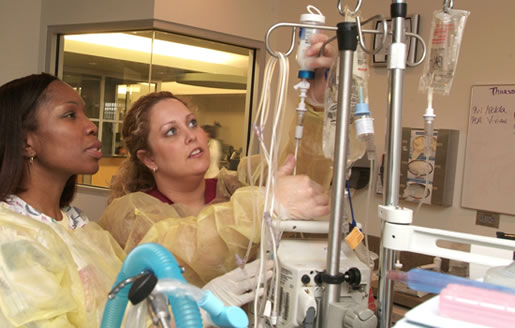In today’s ever-changing health care environment, it’s no longer enough to keep on providing yesterday’s good care.
Getting the best clinical outcomes—and the most patient and family satisfaction—requires caring and then some. Today Emory nurses still bring the cool touch to the fevered brow, but more than tradition, their practice patterns are based on evidence—gleaned from scientific literature or their own research.
Shifting focus
As one example, the nursing literature has shown that outcomes improve when patients and families feel involved in the care plan, but it has offered few roadmaps for how to achieve that result. Emory nurses found a way to enhance patient/family involvement during the change of shift. Traditionally, nurses going off duty have met in a conference room or hallway to update the nurses coming on shift about the patients’ conditions. At Emory, however, these shift reports are done at the bedside, giving patients and families the chance to listen in and add their own comments.
Emory nurses Michelle Gray and Carolyn Hill pioneered bedside shift reporting in the ICU at Emory University Hospital. Building on feedback they got from patients, they wrote evidence-based, standardized guidelines for what nurses should discuss at the bedside and how to do it. Outcomes during their study in the ICU, especially measures of patient satisfaction, improved so much that Emory implemented bedside shift reporting throughout all its hospitals. And the Agency for Healthcare Research and Quality has made a video of the Emory program available to its nurse members nationwide.
Preventing falls
Patient falls make up the single largest category of reported incidents in U.S. hospitals. Emory recently made a series of good-sense moves to reduce falls in its hospitals: replacing all patient beds with new ones that can be lowered closer to the floor, investing in special gel mats to create a soft, bouncy 4-foot radius around the bed of at-risk patients, and creating special “catch a falling star” signage to indicate a patient’s fall risk to anyone who enters the room, from nurses to visitors to maintenance staff. Additionally, nurses regularly visit patient rooms to scan for fall-inducing hazards like a blanket or cord on the floor.
They based a second change on evidence from the scientific literature and Emory’s own records. For example, one study showed that bathroom urgency was a leading cause of patient falls, and another demonstrated that hourly rounds could decrease the number of falls. Emory’s database recorded the frequency and timing of falls in individual units. Based on all the information, administrators instigated hourly nursing rounds, which included “intentional toileting” (not “would you like to …?” but rather “let me help you to the bathroom now”). The rounds were timed to anticipate peak fall times, and as a result, falls—especially serious hip-breaking, head-hitting falls—are declining. Plus, patients seem to enjoy the regular contact.
Removing restraints
Some improvements reported in the literature are so obviously a good fit for Emory’s strides to improve quality that the decision is to “just do it,” says Sharlene Toney, Emory Healthcare’s executive director for professional nursing practice.
How, for example, to avoid using physical restraints on confused patients who persist in ripping out IV tubes? Recent studies suggested that special aprons with zippers, buttons, and tags work for patients with “active hands” and that tubing or monitor wires can be run under special skin-colored sleeves where they won’t be visible to easily distracted patients. After Emory implemented the devices, along with other changes, the need for restraints plummeted.
Fine-tuning dialysis
The acute hemodialysis units at Emory University Hospital (EUH) and EUH Midtown differ slightly in the time that elapses between end of a dialysis session and blood glucose testing for diabetic patients. When Emory nurses wanted to optimize treatment, they wondered what should be the standard of care? Finding no answers in the literature, they made calls to other hospitals, turning up a range of waiting times, none of which was based on clinical evidence. With help from the Emory Atlanta Clinical and Translational Science Institute, Emory nurses designed their own study—now under way—with a grant from the American Nephrology Nurses Association. Three additional clinical nursing research studies at Emory are generating information on patients ranging from newborns to older adults. The goal of all of these evidence-based initiatives is improved patient outcomes and quality of care, says Susan Shapiro, who oversees nursing research for Emory Healthcare.

